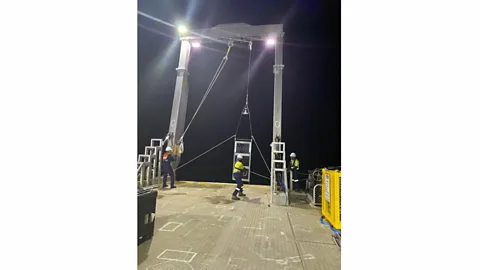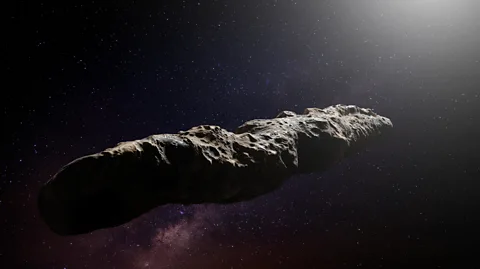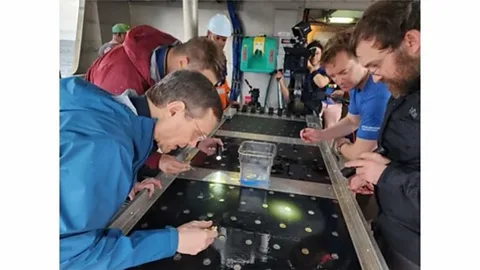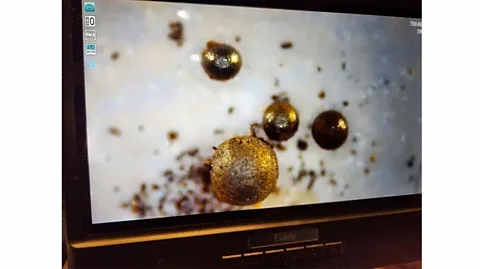The underwater search for an alien meteor
 Getty Images
Getty ImagesThe relics of the first interstellar meteor are thought to lie at the bottom of the Pacific Ocean. Last week one controversial scientist and his team claimed to have found them.
Deep beneath the Pacific Ocean, in an inky abyss roughly a mile (1.6km) underwater, a curious black-and-silver beast is stirring up mud. With a spotted metallic body and wriggling umbilical of purple rope, to the region's own eccentric deep-sea fauna it might resemble a kind of rectangular stingray. This is the world's first "interstellar hook" – a unique contraption designed and deployed by the controversial Harvard physicist Avi Loeb. It is on the hunt for alien material – and it may have found something.
Rewind four years, and Loeb was thinking about another strange object: the cigar-shaped comet Oumuamua, which silently slipped past our planet in October 2017, only to disappear forever into the void of space. This was Earth's first known interstellar visitor – a rogue voyager that may have travelled for some 600,000 years to reach our little blue marble. Loeb's quest to understand it earned him a new nickname – "The alien hunter of Harvard" – a bestselling book, and no small degree of criticism from fellow scientists.
With this comet in mind, Loeb decided to search for other cosmic anomalies. And this is what led him, via a team of university students and a handy online catalogue of fireballs detected around Earth, to "IM1" – a weird meteorite that exploded over the Pacific Ocean at 3.05am local time on 9 January 2014.
Now Loeb thinks he has found some remnants of this celestial interloper. Could these rare fragments, each around a third of a millimetre across, be debris from a distant Solar System? Has he really managed to sift them out from the vastness of the Pacific? And just why is the search so provocative?
A stark reminder
It's a startling fact that no human has ever personally encountered material from outside our Solar System – at least, not knowingly.
Despite 66 years of space exploration and hundreds of missions collecting samples from the moon, solar wind, asteroids and low-earth orbit – as well as the more than 70,000 meteorites that have been found on the surface of our planet – the space debris scattered across the world's museums is all from our own cosmic neighbourhood.
Even the dinosaur-killing imposter that slammed into the Earth 66 million years ago is thought to have come from the Oort cloud, a mass of comets at the farthest edge of our Solar System which regularly throws rocks our way. (Learn more from BBC Future about the mysteries of the Oort cloud.)
"The planetary science community has gathered an amazing body of knowledge about these objects, but we have never been able to study material from another Solar System – the planets and asteroids found around a distant star," says Marc Fries, cosmic dust curator at Nasa. "We know those systems exist, but have never been able to study them in the laboratory."
 Abraham Loeb
Abraham LoebEverything we know about the space beyond our own patch comes from observing the light that has made it at least 40 trillion km (25 trillion miles) – the distance from the next nearest Solar System, Alpha Centuri – to our planet. The rest is a series of educated guesses, based on the chemistry and physics of our own neighbourhood. We can only imagine the exotic compounds these remote territories contain. At least, for the moment.
A rare event
At first, IM1 was just a handful of numbers in an online database, under the label "CNEOS 2014-01-08".
Though space is constantly under watch from the roughly 10,000 professional astronomers that inhabit the Earth, together with thousands more amateur enthusiasts, meteorites are easily missed. The sky is simply too big to be monitored in its entirety, all of the time – and most telescopes aren't sensitive enough to detect small objects.
So, when IM1 slammed into the Earth, no one noticed. The only record of its existence came from the US government, whose sensors recorded its trajectory, speed and altitude as it streaked through the atmosphere over the Atlantic Ocean near Portugal. Any further details, if they exist, are found in classified documents – not because it was a UFO, but because making them public would reveal too much about the capabilities of the military equipment that found it.
But there were enough crucial details in the database to pique Loeb's interest. For a start, IM1 was hurtling along at an uncanny speed.
All the stars in the Milky Way are moving – gradually orbiting its centre, though in the case of our Sun a single revolution can take about 230 million years. As they travel, they take the contents of their Solar Systems with them. This means that any object that entered our solar neighbourhood would already be bringing the speed set by its own star. As it got closer to the Sun's gravitational pull it would "fall" towards it, increasing its pace yet further. As a result, scientists expect that interstellar meteorites would be moving faster than regular ones.
Loeb's analysis suggests that not only was IM1 moving more rapidly than our own Solar System, it was also travelling faster than 95% of the stars nearby. This, he believes, suggests that it was interstellar. However, even factoring this in, it's not clear how it achieved such momentum.
Secondly, the meteorite was extremely tough – instead of breaking up in the Earth's upper atmosphere, IM1 held on until it reached the lower atmosphere. Exactly what it was made of remains a mystery – but it was more robust than steel.
"We found that its material strength must be at least a few times bigger than all other space rocks, 272 of them [at the time] in the same catalogue," said Loeb, in an interview with the BBC a couple of weeks before the expedition started.
Together with a colleague from Harvard, Loeb calculated with 99.999% confidence that IM1 was an interstellar visitor. This would have made it only the third ever discovered, after the comet 2I/Borisov, which was discovered in August 2019, and Oumuamua – only this time, it had ended up within reach. But there was a catch.
When the team wrote up their findings, the paper was initially rejected for publication in a scientific journal, partly because the experts reviewing it felt they needed more detail. In need of urgent access to classified documents, Loeb's mission stalled.
 Getty Images
Getty ImagesThen, after years of petitioning the White House for further information, earlier this year Nasa received a letter. Signed by the US Space Force Lieutenant General, with a blue seal from the Department of Defense, it confirmed that they had checked Loeb's workings with the chief scientist at the US Space Operations Command, and confirmed they were "sufficiently accurate" to suggest the mystery meteor came from interstellar space.
"That was really unusual because the Department of Defense came to my defence, so to speak," said Loeb.
Some Nasa scientists remain unconvinced.
"The study of astromaterials has revolutionised our understanding of the history of our own Solar System, and if we could make the same studies of astromaterials from another… then we would start down the road towards a similar level of understanding of that distant system," says Fries. However, extraordinary claims require extraordinary evidence – and he advises caution.
"At present, it is not clearly demonstrated that this body is interstellar in origin and in fact an expert in meteoroids made a presentation earlier this week at the Asteroids, Comets, and Meteors 2023 conference showing that the best explanation for 'IM1' may be a fairly common, rocky meteoroid from within our own Solar System," says Fries.
Fries also explains that it's important to consider where the data about IM1's trajectory came from – probably a suite of sensors built to watch for nuclear explosions. These would not be designed to make high-accuracy measurements of meteor velocities, he notes. And because the details remain hidden, he says it's impossible to rigorously peer-review the data.
Two other scientists contacted by the BBC refused to comment as they did not wish to be associated with Loeb's claims.
But if IM1 really did have the features Loeb has uncovered, it raises a number of questions – none of which yet have established answers. What could it possibly have been made of? And how did it end up travelling so fast?
Explanations range from the relatively sober – such as the idea it originated within a distant supernova, the explosion of a massive star – to the arguably absurd. Loeb has dared to propose that the meteor could represent technology from an alien civilisation. And this speculation garners even less support.
David Spergel, emeritus professor of astrophysical sciences at Princeton University, who is currently chairing Nasa’s independent study on unidentified anomalous phenomena (UAPs), agrees that IM1 was an intriguing object – though he says this doesn't mean it was made by intelligent extraterrestrials.
"It will tell us something about how planet formation proceeds," says Spergel, who does, however, believe that it is most likely a rock from outside our own Solar System. "So, you know, I think this is an example of an interesting study and that Avi was motivated to study a region of parameter space that people hadn't looked at. I don't see any reason to think that this represents an alien technology, as opposed to, you know, an asteroid that hit the Earth," he says.
There is only one way to find out.
 Abraham Loeb
Abraham LoebA daring search
Loeb's meteor search team arrived onboard the Silver Star on 14 June, and soon arrived at a patch of velvety-blue ocean around 84km (52 miles) from the tropical shores of Manus Island, Papua New Guinea. This is where, using a combination of US military data and local seismology readings, Loeb calculates the debris from the meteorite will have landed.
Armed with their "interstellar hook" and more than $1m (£786,000) in backing from the founder of the blockchain company Cardano, the team began the journey by collecting control samples from outside their search area, which is being used for comparison with debris from IM1. The hook is designed like an underwater sled and is towed behind the ship from a long rope. It can either pick up samples of potential meteor debris using the spots on its surface, which are powerful magnets, or with less discerning collection nets.
You might also like:
This is crucial, because what Loeb and his team have been hoping for – other than a large chunk of debris – are spherules. These tiny spheres of metal or glass, often roughly 1mm across, are formed in the incandescent blaze as meteorites or asteroids explode, and have been found at impact sites all over the world.
Last year, scientists at Tanis, a fossil site in North Dakota where it's thought many dinosaurs and other animals were entombed on the day of the fateful era-ending asteroid strike, announced that they had found similar tiny clues inside fossilised fish. The spherules were still in the creatures' gills, where they were breathed in 66 million years ago.
Though almost a decade has passed since debris from the meteor rained down over the Pacific Ocean, Loeb is confident that at least some of these spherules will still be lurking close to the surface of the seabed. And if IM1 contained a magnetic material such as iron – which is commonly found in meteorites – the plan was that some of these tiny particles might be picked up.
 Abraham Loeb
Abraham LoebA handful of hints
To begin with, the team found a jumble of miscellaneous ocean debris – a combination of natural materials and rubbish from millennia of trade and war. (Read more from BBC Future about the history hidden in the world's oceans). They found wires, mysterious scapings of metal, and even tiny spheres of material – but after further investigation, each turned out to have biological or man-made origins. The team tweaked the search area, and considered switching to the non-magnetic collection method: perhaps the meteor wasn't made from metal after all?
Then on 21 June, they finally had some luck. As Loeb reported in his blog about the expedition, a team-member came running down the stairs to inform him they had a spherule – a tiny metallic pearl, as he put it, about 0.3mm across. It soon transpired that this was one of many, and was composed primarily of iron, magnesium and titanium. Loeb notes that this is an unusual combination, both in human-made objects and meteorites.
Could this be the first contact humans have ever had with a material from outside our Solar System?
Even with spherules, Loeb's team are a long way from establishing their link to IM1. "Tiny metallic spherules are exceedingly common on Earth," says Fries. They come from automobile exhaust, vehicle brakes, welding, volcanoes, and probably some more sources we haven't identified," he says.
Fries explains that there are certain clues that can indicate they have come from space, including an iron oxide called wustite, the presence of nickel and certain isotopes.
And even if the spherules are confirmed to have origins beyond everyday processes on Earth, it's possible that they didn't come from IM1. It's thought that around 500 meteorites slam into the Earth every year, so this fragment may have come from another impact.
Loeb remains optimistic. The team plans to take the spherules to Harvard College Observatory, where they will use spectrometry to identify the isotopes within – by analysing their proportions relative to other meteorites, Loeb hopes to test whether IM1 really did have interstellar origins. Alternatively, he suggests, it might confirm that they weren't formed – but made, possibly by intelligent aliens.
In any case, Loeb believes that there is no harm in checking.
On this, even Fries agrees – as long as the correct scientific process is followed. "Science is wonderful in that it is one of the most forgiving human institutions in existence," he says. "Any scientist may propose any hypothesis, and any other scientist may test that hypothesis… everyone learns something new and progress is made towards the truth of the issue…We shall see how that proceeds in this particular case."
--
